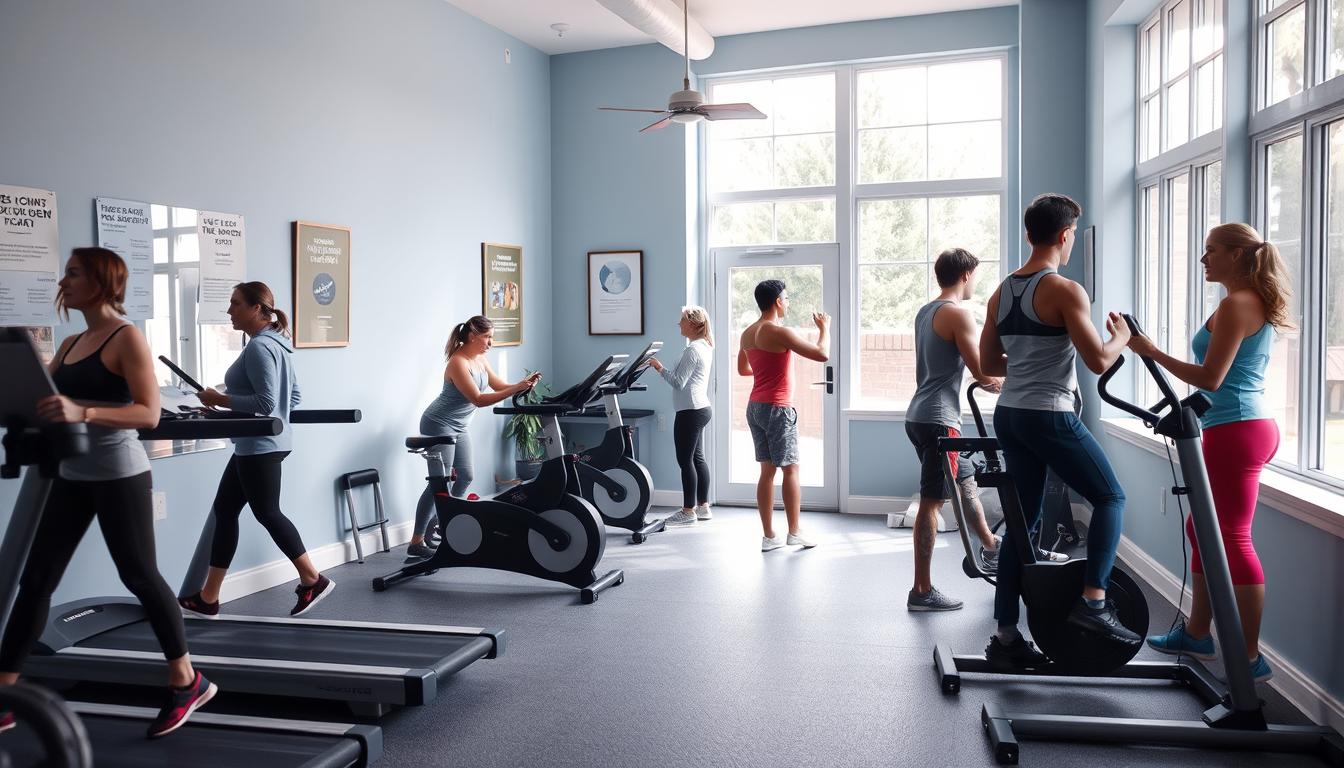Sempre acreditei que pequenas mudanças podem levar a grandes resultados. Alguns anos atrás, decidi incorporar mais movimento à minha rotina diária, e isso transformou minha vida. Desde melhorar meu humor até melhorar meu sono, experimentei em primeira mão como permanecer ativo pode fazer a diferença. Não se trata apenas de condicionamento físico — trata-se de se sentir melhor todos os dias.
Seja você um pai ocupado, um profissional que trabalha ou um aposentado, encontrar maneiras de se manter ativo é essencial. Pesquisas mostram que o movimento regular pode reduzir o risco de doenças crônicas, como doenças cardíacas e diabetes. Ele também melhora a saúde do cérebro e a função cognitiva, mantendo você afiado conforme envelhece.
Neste artigo, compartilharei dicas práticas para ajudar você a se manter ativo, não importa sua idade ou estilo de vida. De exercícios simples a atividades divertidas, há algo para todos. Vamos explorar como você pode tornar o movimento parte de sua vida diária e colher as recompensas.
Principais conclusões
- O movimento regular reduz o risco de doenças crônicas, como doenças cardíacas e diabetes.
- A atividade física melhora a saúde do cérebro e a função cognitiva.
- Até mesmo exercícios moderados podem melhorar o humor e a qualidade do sono.
- Diferentes faixas etárias se beneficiam de recomendações de atividades personalizadas.
- Incorporar variedade nas rotinas de exercícios evita tédio e lesões.
Introdução à minha jornada com a atividade física
Nunca pensei que gostaria de ficar ativo até tentar. No começo, não tinha certeza do que significava viver um estilo de vida ativo. Para mim, não se tratava de ir à academia todos os dias ou correr maratonas. Tratava-se de encontrar maneiras de me movimentar mais na minha vida diária.
✅ Get Your Exclusive Offer Now!

Compreendendo o que significa movimento
Movimento, para mim, é qualquer ação que faça meu corpo funcionar. Pode ser dançar na minha sala de estar, dar uma volta depois do jantar ou até mesmo fazer jardinagem. Pesquisas mostram que atividades de intensidade moderada como essas podem atingir os 150 minutos recomendados por semana. Não se trata de perfeição, mas de consistência.
Como comecei meu estilo de vida ativo
Comecei devagar. Em vez de ficar sentado o dia todo, fiz pequenas pausas para me alongar ou caminhar. Tentei atividades que gostava, como dançar ou jardinagem. Com o tempo, notei melhorias na minha força muscular e nos meus níveis de energia. Como adulto, essas mudanças fizeram uma grande diferença em como me sentia todos os dias.
Entender os níveis recomendados de movimento reformulou minha visão sobre saúde. Percebi que todas as pessoas podem se beneficiar de movimentos regulares, não importa seu nível de condicionamento físico. Não se trata de fazer tudo de uma vez — trata-se de dar um passo de cada vez.
Minha experiência pessoal: abraçando uma vida ativa
Dar pequenos passos em direção a um estilo de vida ativo mudou minha vida de maneiras que eu nunca esperava. Comecei adicionando apenas 10 minutos extras de movimento ao meu dia. Com o tempo, essas pequenas mudanças me ajudaram a controlar meu peso e melhorar minha saúde óssea. É incrível como pequenos ajustes podem levar a grandes resultados.
🚀 Last Chance! Click Here Now!

Comecei integrando atividades simples à minha rotina. Por exemplo, eu fazia caminhadas curtas após as refeições ou alongamentos leves durante os intervalos. Essas sessões curtas, medidas em minutos, gradualmente construíram minha força e resistência. Consistência era a chave.
Lições aprendidas ao permanecer ativo
Uma das maiores lições que aprendi é que o movimento não precisa ser intenso para ser eficaz. Até mesmo atividades moderadas, como jardinagem ou dança, podem fazer a diferença. Pesquisas mostram que apenas 150 minutos de atividade de intensidade moderada por semana podem melhorar a saúde geral.
Outra lição é a importância da paciência. O progresso não acontece da noite para o dia, mas pequenos esforços consistentes se somam. Por exemplo, notei melhorias nos meus níveis de energia e humor algumas semanas após começar minha rotina.
Aqui está um detalhamento de como estruturei minhas atividades diárias:
| Atividade | Duração | Impacto |
|---|---|---|
| Caminhada matinal | 15 minutos | Energia aumentada para o dia |
| Pausas de alongamento | 5 minutos, 3x/dia | Flexibilidade melhorada e rigidez reduzida |
| Ioga à noite | 20 minutos | Melhor relaxamento e qualidade do sono |
Essas maneiras simples de permanecer ativo se tornaram uma parte natural do meu dia. Elas não só me ajudaram a controlar meu peso, mas também fortaleceram meus ossos e minha saúde geral. É a prova de que cada minuto conta.
Benefícios da atividade física para a saúde
Percebi como permanecer ativo transformou não apenas meu corpo, mas minha mente também. Com o tempo, experimentei um pensamento mais aguçado e melhor recuperação da memória. Essas mudanças fizeram uma diferença significativa na minha vida diária. É incrível como o movimento pode aumentar o poder do seu cérebro.
💪 Transform Your Health Today!

Pensamento mais aguçado e equilíbrio emocional
O movimento regular me ajudou a me sentir mais focado e menos sobrecarregado. Estudos mostram que até mesmo exercícios moderados podem reduzir sentimentos de depressão e melhorar o humor. Descobri que uma caminhada rápida ou um treino curto podem levantar meu ânimo e limpar minha mente.
Pesquisas apoiam esses benefícios. Por exemplo, um estudo descobriu que apenas 30 minutos de movimento de intensidade moderada podem melhorar a função cognitiva. Isso mudou o jogo para mim, especialmente durante dias ocupados ou estressantes.
Construindo força e resistência
Além da clareza mental, permanecer ativo melhorou minha resistência física. Notei músculos mais fortes e melhor resistência ao longo do tempo. Isso tornou as tarefas diárias mais fáceis e mais agradáveis.
Consistência é a chave. Ao manter uma rotina, vi melhorias de longo prazo na minha saúde mental e física. É a prova de que pequenos esforços regulares podem levar a grandes resultados.
Atividade física regular e controle de peso
Manter um peso saudável sempre foi uma prioridade para mim, e o movimento regular mudou o jogo. Combinar exercícios com alimentação consciente me ajudou a equilibrar minha ingestão de calorias e gasto de energia. Não se trata apenas de perder peso — trata-se de me sentir forte e energizado todos os dias.

Equilibrando calorias e energia
I’ve learned that managing weight is all about balance. By tracking my calorie intake and ensuring I burn enough energy through movement, I’ve been able to maintain a healthy weight. Activities like brisk walking and cycling have been particularly effective for me.
Research shows that combining exercise with a calorie deficit is key to weight loss. For example, studies suggest that burning 400-600 calories daily through movement can lead to significant results. It’s not about extreme measures—it’s about consistency.
Building Muscle and Bone Strength
Strength training has been a cornerstone of my routine. Activities like weight lifting and resistance exercises have helped me build muscle and improve bone density. Over time, I’ve noticed stronger muscles and better posture.
Studies indicate that regular strength training can reduce the risk of osteoporosis and improve overall strength. It’s also been linked to better heart health and improved blood circulation. Every rep counts.
Here’s a quick breakdown of my weekly routine:
- Brisk walking: 30 minutes, 5 days a week
- Weight lifting: 20 minutes, 3 days a week
- Yoga: 15 minutes, 2 days a week
By sticking to this plan, I’ve not only managed my weight but also improved my overall health. It’s proof that small, consistent efforts can lead to big results.
Preventing Chronic Diseases Through Exercise
Staying active has become my shield against chronic illnesses over the years. Regular movement has not only improved my fitness but also significantly lowered my risk of serious health conditions. From heart disease to diabetes, I’ve seen firsthand how exercise can be a powerful preventive measure.
One of the most significant changes I’ve noticed is how consistent workouts have helped manage my blood pressure. Studies show that even moderate activities, like brisk walking, can reduce the risk of heart disease and stroke. It’s a simple yet effective way to protect your heart.
Lowering Heart Disease and Stroke Risks
I’ve made it a habit to engage in at least 150 minutes of moderate exercise each week. Activities like cycling and swimming have been particularly beneficial. Research indicates that this level of movement can lower the risk of cardiovascular conditions by up to 30%.
Here’s a quick look at how I structure my weekly routine:
| Activity | Duration | Impact |
|---|---|---|
| Brisk Walking | 30 minutes, 5 days/week | Reduces blood pressure |
| Cycling | 20 minutes, 3 days/week | Improves heart health |
| Swimming | 25 minutes, 2 days/week | Boosts overall fitness |
Managing Diabetes and Other Conditions
Regular exercise has also played a key role in managing my blood sugar levels. For those with diabetes, activities like walking or light strength training can make a big difference. Consistency is key to seeing results.
I’ve also learned that staying active can lower the risk of certain cancers. Studies suggest that regular movement reduces the likelihood of breast, colorectal, and prostate cancers. It’s a proactive step toward long-term health.
As I age, I’m more committed than ever to maintaining an active lifestyle. It’s not just about staying fit—it’s about preventing conditions that can impact quality of life. Every step counts.
Boosting Mental Health and Well-being with Exercise
Exercise has become my go-to solution for mental clarity and emotional balance. Over the years, I’ve noticed how even a short workout can lift my spirits and clear my mind. Whether it’s a brisk walk or a yoga session, movement has been a powerful antidote to stress and anxiety.
One of the most immediate benefits I’ve experienced is the boost in mood after a structured exercise session. Studies show that even 30 minutes of moderate movement can enhance cognitive function and reduce feelings of depression. It’s amazing how a quick workout can turn a rough day around.
Making Time for Mental Health
Finding time for exercise throughout the year has been essential for my mental well-being. I’ve learned to prioritize movement, even on busy days. Whether it’s a morning jog or an evening stretch, these small efforts have made a big difference.
Here’s how I’ve structured my routine to stay consistent:
| Activity | Duration | Impact |
|---|---|---|
| Morning Walk | 20 minutes | Boosts energy and focus |
| Yoga Session | 15 minutes | Reduces stress and anxiety |
| Evening Stretch | 10 minutes | Improves relaxation and sleep |
Staying motivated can be challenging, but I’ve found that setting realistic goals and tracking progress helps. Consistency is key. Even on days when I don’t feel like moving, I remind myself of the positive impact it has on my mental health.
Exercise has become an integral part of my strategy for maintaining mental well-being. It’s not just about physical fitness—it’s about feeling balanced and energized every day. Every step counts.
Everyday Tips to Incorporate Activity into My Life
Finding ways to stay active has become a natural part of my life, and it’s easier than I thought. Whether at home, in the office, or during free time, I’ve discovered simple strategies to keep my body moving. These small changes have helped me reduce risk of conditions like diabete while staying agile and energized.
Simple Home and Office Workouts
I’ve found that short bursts of movement can make a big difference. At home, I do quick stretches or bodyweight exercises like squats and lunges. In the office, I take short breaks to walk around or do desk-friendly exercises like seated leg lifts. These activities help me stay active without disrupting my schedule.
Here’s a quick table of my go-to exercises:
| Activity | Duration | Impact |
|---|---|---|
| Stretching | 5 minutes | Improves flexibility |
| Desk Push-Ups | 3 sets of 10 | Strengthens upper body |
| Seated Leg Lifts | 2 minutes | Engages core muscles |
Creative Ways to Stay Active Daily
I’ve also incorporated movement into everyday tasks. For example, I take the stairs instead of the elevator or park farther away to add extra steps. Even household chores like sweeping or gardening can be a great workout if done briskly. These small changes help me stay consistent and reduce risk of a sedentary lifestyle.
For older adults, choosing the right type of activity is key. Low-impact exercises like walking or yoga can be effective and safe. I’ve also found that social activities, like walking with a friend, make movement more enjoyable and sustainable.
Here are a few creative ideas I use:
- Dance to your favorite songs for 10 minutes.
- Take a walk during phone calls or meetings.
- Use a standing desk or balance board at work.
By making movement a part of my daily routine, I’ve not only improved my body but also reduce risk of chronic conditions. It’s proof that small, consistent efforts can lead to big results.
Staying Active Safely: Listening to My Body
Listening to my body has helped me exercise smarter, not harder. Over time, I’ve learned that recognizing my limits is key to staying injury-free. Whether it’s adjusting intensity or taking breaks, paying attention to how I feel has made my workouts safer and more effective.
One of the most important lessons I’ve learned is the difference between moderate and vigorous exercise. While both have benefits, understanding when to choose one over the other has been crucial. For example, on days when I feel fatigued, I opt for a brisk walk instead of a high-intensity run. This not only keeps me active but also reduces the risk of overexertion.
Choosing the Right Intensity
Recognizing early signs of fatigue has allowed me to adjust my workouts safely. Studies show that even a small amount of movement, like walking for the least minute, can lower the risk of heart disease. This has motivated me to stay consistent, even on busy days.
Here’s how I structure my weekly routine to balance intensity:
| Activity | Intensity | Duration |
|---|---|---|
| Brisk Walking | Moderate | 30 minutes |
| Cycling | Vigorous | 20 minutes |
| Yoga | Light | 15 minutes |
Planning the amount of exercise has also improved my energy levels. By gradually increasing intensity, I’ve avoided injuries and felt stronger over time. It’s not about pushing harder—it’s about moving smarter.
“Even a little movement can make a big difference in reducing the risk of cardiovascular disease.”
For those just starting, I recommend listening to your body and choosing activities that feel right. Whether it’s a short walk or a gentle stretch, every least minute counts. Heart disease prevention starts with small, consistent efforts.
By prioritizing safety and gradually increasing intensity, I’ve not only improved my fitness but also reduced the risk of cardiovascular disease. It’s proof that staying active safely can lead to long-term health benefits.
Conclusion
Embracing movement has been a game-changer in my life, transforming both my body and mind. Through consistent effort, I’ve experienced measurable health benefits, from maintaining lower blood pressure to reducing my risk heart conditions. These changes have not only improved my physical resilience but also brought mental peace and clarity.
Small, daily adjustments have made a big difference. Whether it’s a brisk walk or a quick stretch, every step helps lower blood pressure and supports overall well-being. I’ve learned that even modest efforts can help prevent health loss and boost energy levels.
I encourage you to start small. Simple changes, like taking the stairs or stretching during breaks, can help reduce your risk heart issues and improve your quality of life. The journey to better health begins with one step—take it today and experience the long-term health benefits of staying active.
FAQ
How does staying active improve my brain health?
Can exercise help me manage my weight?
What are the advantages of building muscle and bone strength?
How does physical activity lower my risk of heart disease?
Can staying active help with mental health?
What are some easy ways to stay active daily?
How do I know if I’m exercising at the right intensity?
Os exercícios podem ajudar a controlar o diabetes?
Quanto tempo devo dedicar à atividade física por semana?
Quais são os benefícios a longo prazo de permanecer ativo?
Did you like this article? See also: Top High-Protein Foods to Power Your Diet







